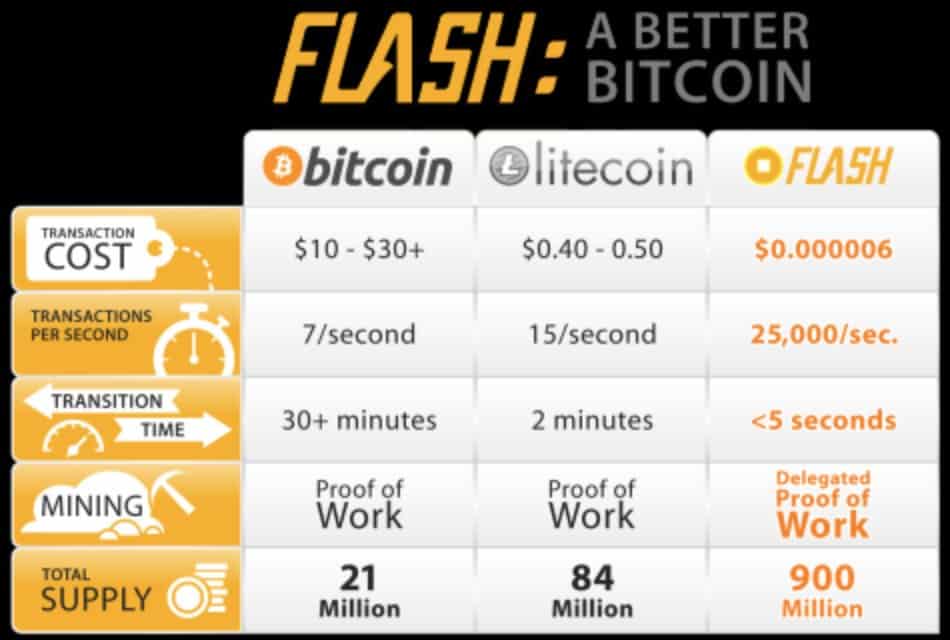Flash is a little-known cryptocurrency that is growing its presence in Venezuela and Africa. It was not designed as a proof-of-work system, although it uses Mining for transaction verification and network security, and is focused on fast transactions that take a matter of seconds.

Recently, cryptocurrency developers have integrated into the mobile wallet the “person-ATM” option, the P2Р trading functionality, which can gain popularity in jurisdictions where paper money is hardly trusted (for example, in Venezuela).
As a cryptocurrency project, it may encounter development problems due to technical design - partly due to competition in bitcoin and lightcoin mining. In Flash, a small number of miners ensure network security and process transactions for a very small profit. Despite this, Flash has a mobile application that allows you to store several cryptocurrencies - Bitcoin, Litecoin, Dash, Ethereum, as well as Flash token itself. Flash is also available in the popular Coinomi multiple currency cryptograph.
Flash primarily focuses on distribution to merchants and users of peer-to-peer networks where other methods are unavailable or unreliable. Venezuela has become a model for the use of cryptocurrency, but there are other regions where digital currencies will give sellers the opportunity to accept not only cash at low costs and with much lower fees than when processing payment cards. Flash marketing director James Hinton (James Hinton) said that at least 800 vendors in Africa will start accepting tokens in the coming months, which automatically means taking Bitcoin, Dash, Litecoin, Ethereum.
Creating a mobile wallet Flash account provides users with access to the web version of the wallet, which has more than 20 tokens based on the ERC-20 protocol, in addition to the usual cryptocurrencies.
The multicurrency full-featured wallet probably got its share of installations in the app stores, but now the developers have added something of international interest: the РХNUMXР trading function, called the ATM-man.
Trading Р2Р-platform on a chain
The “human terminal” option is unique and is associated with the movement of a mobile wallet. She invites users to download a map of people offering a personal transaction. Transactions can be carried out personally, and funds transferred through the application. As in LocalBitcoins, there is a rating and review system. Of course, in carrying out such transactions it is better to meet in crowded places and use the best methods of precaution.
In Venezuela, this allows everyone to turn into a strolling bitcoin terminal, even if they themselves conduct transactions in Flash. Flash is supported by the Einstein Exchange in Canada, which allows customers to link their bank accounts and corresponding payment methods (for example, debit or credit cards) for external transfers. Some small exchanges also support Flash cryptocurrency.
The token has more than 800 000 active addresses worldwide. In the two weeks that have passed since the launch of the new function, dozens of new application installations have been made in Africa and Venezuela. The Seychelles Crowdforce announced the start of cooperation with the project in its tweeter account.
Crowdforce's PayForce network includes 8000 merchants, all of whom will now accept cryptocurrency via Flash, including Flashcoin.
From this position, Flash cryptocurrency is not as important as the potential capabilities of its mobile wallet. People are like a peer-to-peer network, and the success of eBay as a global trading platform, or the almost instant success of the Facebook trading platform, proves that if people can deal directly with people, they do.
The wallet is available in the Play Store and the Apple App Store.
Coinbase for the world outside the banks
For the part of the world not covered by banking services, “man-ATM” is incredibly important, as well as for sellers from poor regions. Just as Coinbase and its competitors make it easier for people in the regions to fully support the traditional financial system, Flash Wallet allows the world to live outside of this system in the same way, but potentially with much lower commissions.
A typical interaction, apparently, will occur as follows: an agricultural worker goes with his salary in cash, not trusting banks and other institutions, even if there are any, makes an order from the seller to buy a certain amount of cryptocurrency in order to preserve his salary. Then he can pay this cryptocurrency with other vendors, or, more importantly, spend it online. Or he may just get a chance to enter the crypto market, where you can transfer money to the stblcoins and, ultimately, the Western banking system if desired.
“ATM-person” transactions do not occur anywhere outside the wallet chain. If you sold one cryptocurrency for another in the application, you pay a commission only on the sales network, and the buyer pays a commission on the network of the cryptocurrency that he paid you with. This means that there is no need for staff who will monitor the correctness of transactions, because all transactions are conducted on a secure and transparent blockchain.
Reverse side of personal transactions
Like any peer-to-peer interaction, there remains the risk of being deceived. Online transactions that can be done in the application, is an attempt to prevent such situations. Flashcoin is not needed for such a transaction.
Yet simple peer-to-peer trading methods that would support several currencies at the same time are still very rare. But they are very necessary for the universal adoption of cryptocurrency by individuals, and the Flash team has become an innovator in this matter.
Installing and using a mobile Flash application gives users another account in the web version of the wallet that supports 66 basic tokens based on the ERC-20 protocol, in addition to the capabilities of the mobile application.
